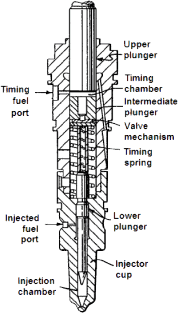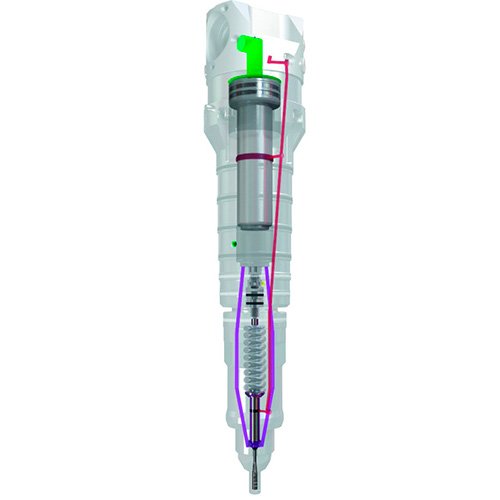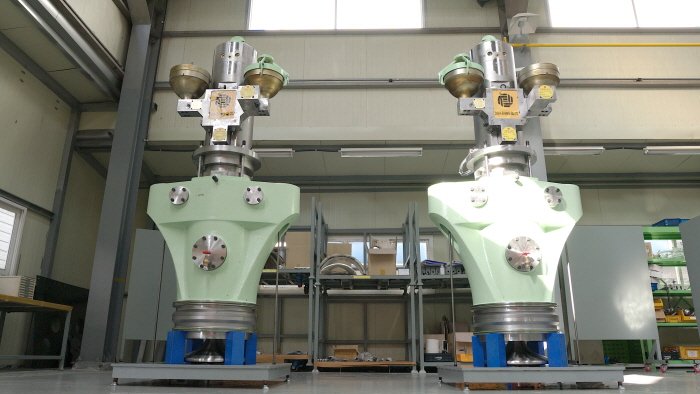Fuel Booster Injection Valve (FBIV)
The Fuel Booster Injection Valve (FBIV) is a crucial component in modern slow-speed marine engines, designed to enhance fuel injection efficiency and optimize engine performance. This article delves into the purpose, operation, and working of FBIVs, with insights into designs from leading manufacturers like MAN B&W, Sulzer, Wärtsilä, and Mitsubishi Heavy Industries.

Purpose of the Fuel Booster Injection Valve (FBIV)
FBIVs serve several essential functions in marine engines:
- Enhancing Fuel Injection Efficiency: The primary purpose of the FBIV is to improve the efficiency of the fuel injection process. By precisely controlling the timing and pressure of fuel injection, FBIVs ensure optimal combustion, leading to better fuel efficiency and reduced emissions.
- Optimizing Combustion: FBIVs help in achieving a more complete and controlled combustion process by delivering fuel at the correct pressure and timing. This results in a more efficient burn, reducing the amount of unburned fuel and lowering the production of harmful emissions.
- Reducing Emissions: By optimizing the fuel injection process, FBIVs help in reducing the emission of pollutants such as nitrogen oxides (NOx) and particulate matter. This is crucial for meeting stringent environmental regulations and ensuring cleaner engine operation.
- Improving Engine Performance: Precise fuel injection timing and pressure contribute to better engine performance. FBIVs enable engines to operate more smoothly, with improved power output and reliability.
Operation of the Fuel Booster Injection Valve (FBIV)
The operation of an FBIV in a slow-speed marine engine involves several key steps:
- Fuel Pressurization: The FBIV receives low-pressure fuel from the fuel supply system. The valve then boosts the pressure of the fuel to the required level for injection into the combustion chamber.
- Controlled Injection: The FBIV precisely controls the timing and duration of the fuel injection. This is achieved through a combination of hydraulic and electronic control systems that ensure the fuel is injected at the optimal point in the engine cycle.
- Fuel Delivery: The high-pressure fuel is delivered into the combustion chamber through the injector nozzles. The design of the FBIV ensures that the fuel is atomized into fine droplets, promoting better mixing with air and more efficient combustion.
- Feedback and Adjustment: Modern FBIVs incorporate feedback mechanisms that monitor the injection process and adjust parameters in real-time. Sensors provide data on injection pressure, timing, and fuel flow, allowing the engine control unit (ECU) to make continuous adjustments for optimal performance.

Working Mechanism of the Fuel Booster Injection Valve (FBIV)
The detailed working mechanism of an FBIV in a slow-speed marine engine can be broken down into several technical aspects:
- Hydraulic System: The FBIV uses a hydraulic system to boost the pressure of the fuel. This system includes a hydraulic pump, accumulator, and control valves. The hydraulic fluid is pressurized and directed to the actuator based on signals from the ECU.
- Actuator Design: The actuator converts hydraulic pressure into mechanical motion. It typically consists of a piston and cylinder arrangement, where the piston’s movement translates to the opening and closing of the fuel injection valve.
- Electronic Control: The ECU plays a critical role in the operation of the FBIV. It continuously monitors engine parameters such as load, speed, and temperature, adjusting the timing and pressure of the fuel injection to optimize performance and efficiency.
- Injector Nozzles: The design of the injector nozzles is crucial for achieving efficient fuel atomization. The nozzles are engineered to create a fine spray of fuel, ensuring thorough mixing with air and promoting complete combustion.
- Feedback Mechanisms: Modern FBIVs incorporate feedback mechanisms to ensure precise control. Sensors monitor the pressure and timing of the fuel injection, providing real-time data to the ECU for continuous adjustment and optimization.

Atomization and Its Importance in Fuel Combustion
One of the key functions of the FBIV is to ensure proper atomization of the fuel. Atomization refers to the process of breaking down liquid fuel into fine droplets, which is crucial for efficient combustion.
- Improved Air-Fuel Mixing: When fuel is atomized into fine droplets, it mixes more thoroughly with the air in the combustion chamber. This homogeneous air-fuel mixture is essential for complete combustion, which maximizes energy extraction from the fuel and reduces the production of unburned hydrocarbons.
- Enhanced Combustion Efficiency: Fine droplets have a larger surface area relative to their volume, which allows for more efficient and quicker burning. This results in a more controlled and complete combustion process, leading to better engine performance and fuel efficiency.
- Reduced Emissions: Proper atomization helps in achieving complete combustion of the fuel, thereby reducing the emission of pollutants. Efficient combustion minimizes the formation of soot and nitrogen oxides (NOx), which are major contributors to air pollution.
- Preventing Engine Knock: Uniform atomization and mixing of fuel help prevent engine knock, which is caused by uneven combustion. Knock can lead to significant engine damage and reduced efficiency, making atomization crucial for the longevity and performance of the engine.
Key Components of the Fuel Booster Injection Valve (FBIV)
The FBIV comprises several critical components, each playing a vital role in its operation:
- Hydraulic Pump: Provides the necessary hydraulic pressure to operate the actuator. It is crucial for boosting the fuel pressure before injection.
- Accumulator: Stores hydraulic fluid under pressure, ensuring a constant supply and smooth operation of the actuator.
- Control Valves: Regulate the flow of hydraulic fluid to the actuator, controlled by signals from the ECU.
- Actuator: Converts hydraulic pressure into mechanical movement, opening and closing the fuel injection valve.
- Injector Nozzles: Ensure fine atomization of the fuel for efficient combustion.
- Sensors: Monitor various parameters such as fuel pressure, injection timing, and flow rate, providing feedback to the ECU.
- Engine Control Unit (ECU): The brain of the FBIV system, it processes data from sensors and adjusts the operation of the FBIV for optimal performance.

Leading Manufacturers: MAN B&W, Sulzer, Wärtsilä, and Mitsubishi Heavy Industries
Several prominent manufacturers have made significant contributions to the design and efficiency of FBIVs in slow-speed marine engines:
- MAN B&W: Known for their innovative engineering, MAN B&W designs FBIVs that optimize engine performance and efficiency. They incorporate advanced materials and precise control systems to enhance the reliability and durability of their valves. MAN B&W’s FBIVs are recognized for their robust construction and effective operation in harsh marine environments.
- Sulzer: Sulzer’s FBIVs are renowned for their high efficiency and reliability. They focus on delivering consistent performance with minimal maintenance requirements. Sulzer’s designs often incorporate features that enhance hydraulic actuation and control precision, resulting in superior performance and fuel savings.
- Wärtsilä: A leading global player in marine and energy markets, Wärtsilä designs FBIVs that are highly efficient and reliable. Their valves are known for their durability and performance, incorporating the latest technological advancements to ensure optimal engine function.
- Mitsubishi Heavy Industries: Mitsubishi designs FBIVs that are durable and efficient, focusing on maximizing the performance of their marine engines. Their designs are known for robustness and reliability in demanding marine environments.
History and Invention of the Fuel Booster Injection Valve
The development of advanced fuel injection systems, including FBIVs, is part of the broader evolution of marine engine technology. The precise history of the FBIV is intertwined with advancements in fuel injection technology in the mid to late 20th century.
The need for more efficient and precise fuel injection systems arose as marine engines became more powerful and environmental regulations grew stricter. Companies like MAN B&W, Sulzer, Wärtsilä, and Mitsubishi Heavy Industries were at the forefront of this development, integrating hydraulic and electronic control systems to improve fuel injection processes.
Conclusion
The Fuel Booster Injection Valve (FBIV) is a critical component in slow-speed marine engines, significantly enhancing fuel injection efficiency, combustion, and emissions control. Understanding its operation and working mechanism is essential for both amateur enthusiasts and experienced marine engineers. Leading manufacturers like MAN B&W, Sulzer, Wärtsilä, and Mitsubishi Heavy Industries continue to advance FBIV technology, driving the marine industry towards greater efficiency and sustainability.
